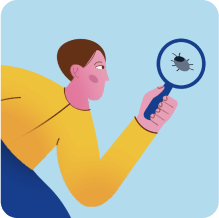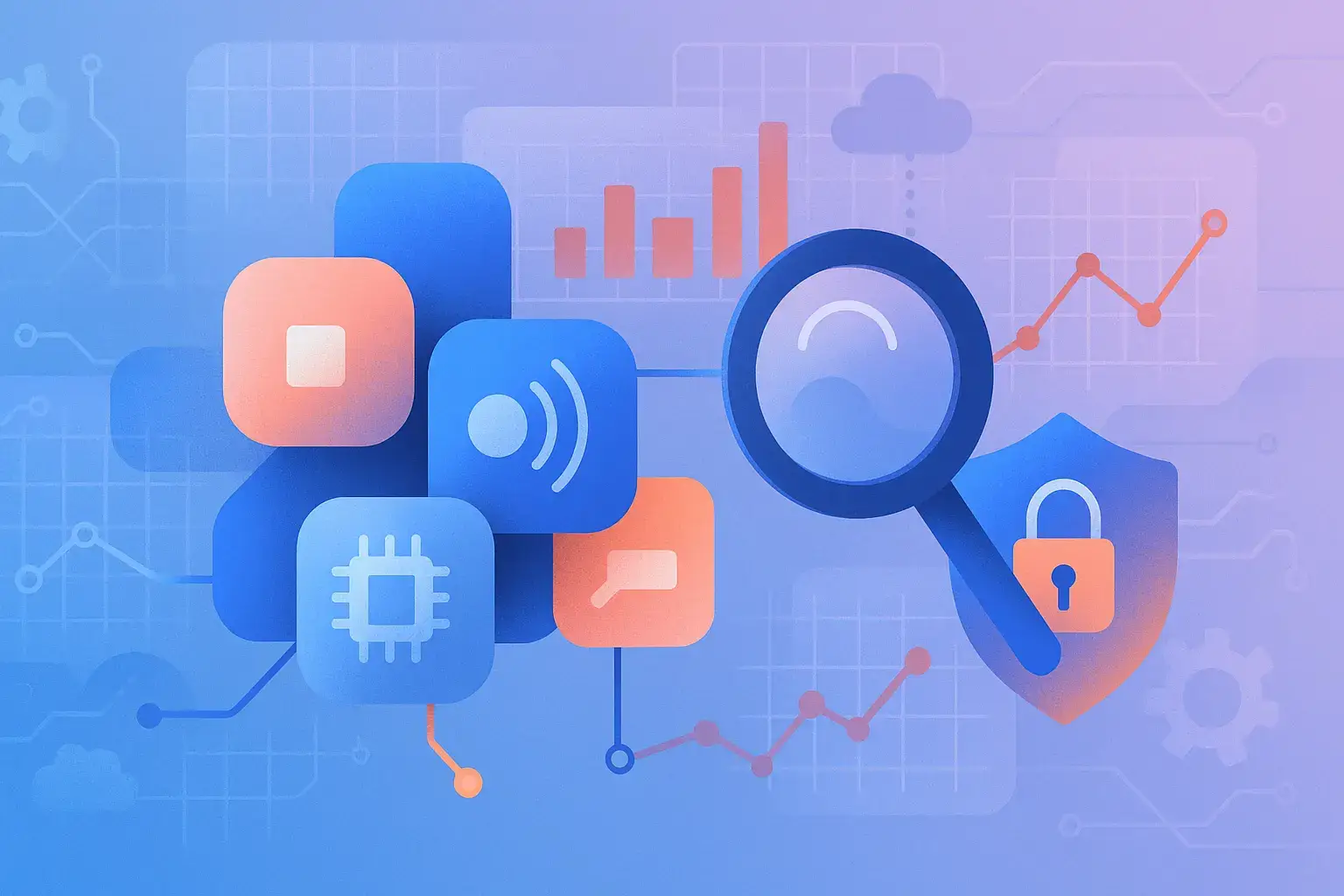What is IoT Software Testing?
IoT software testing is the process of validating that connected devices, their communication networks, and backend systems function correctly, securely, and reliably. Unlike traditional software testing, IoT testing covers a much broader scope – it’s about making sure the entire ecosystem works seamlessly.
The Components of IoT Testing
When you’re testing an IoT system, you’re dealing with interconnected parts that all need to work together seamlessly. Think of it like testing a car – you can’t just check if the engine runs; you need to make sure the brakes work, the steering responds, and all the electrical systems communicate properly. IoT testing breaks down into five main areas that each require their own approach and attention.:
- Device testing: Verifying that the physical IoT device and its embedded software work as intended. This includes testing sensors, actuators, firmware, and any local processing capabilities.
- Network testing: Ensuring reliable communication between devices and gateways or cloud services, even under variable network conditions like weak signals or intermittent connectivity.
- Cloud/backend testing: Validating that server-side components can properly process, store, and respond to device data at scale.
- Integration testing: Confirming that all components work together correctly, from physical sensor readings to user interface displays.
- Security testing: Identifying and addressing vulnerabilities across the entire system, from device firmware to cloud APIs.
What makes IoT testing different is the need to verify both the physical and digital aspects of the system.
Importance and benefits of IoT Software Testing
Skip IoT testing, and you’re playing roulette with your product. The difference between a successful IoT deployment and a costly disaster often comes down to how thoroughly you test before launch. Let’s break down why investing in proper IoT testing isn’t just smart – it’s essential:
Critical Reliability and Safety
When IoT devices fail, the consequences stretch far beyond annoying error messages. We’re talking about real-world impact that can affect lives and livelihoods. Here’s what’s actually at stake:
- Real-world impact means understanding that IoT failures carry serious weight. A malfunctioning medical device could put a patient’s life at risk. A compromised industrial system might damage expensive equipment or injure workers.
- Continuous operation reflects the 24/7 nature of most IoT deployments. Your smart factory sensors can’t take weekends off, and your patient monitoring devices don’t get to sleep. Testing ensures devices can handle years of non-stop operation without breaking down when you need them most.
- Error recovery validates that devices bounce back gracefully from inevitable problems. Power outages happen. Network connections drop. Testing makes sure your devices can handle these disruptions and get back to work without someone having to drive across town to reset them manually.
Security and Privacy Protection
Every connected device you add to your network creates a new potential entry point for trouble. The security challenges multiply quickly, and testing helps you stay ahead of the threats:
- Expanded attack surface: Each connected device potentially adds a new entry point for attackers. Testing helps identify and close security gaps before hackers can exploit them.
- Data protection: IoT devices often collect sensitive information. Testing ensures this data remains encrypted and protected both in transit and at rest.
- Compliance requirements: In regulated industries like healthcare or finance, testing helps verify that IoT solutions meet legal requirements for data handling and security.
Real-world Examples
Take healthcare wearables – these devices literally keep people alive by monitoring vital signs and alerting doctors to emergencies. There can be a scary problem during testing: the heart monitor can drop connection whenever patients shift to certain sleeping positions. Imagine if that bug had made it to market. Patients could have suffered heart attacks while their “working” monitors sat there silently.Smart home testing failures make for expensive lessons. Picture this: you come home from work, and your smart lock won’t let you into your own house. That’s exactly what happened to hundreds of USA citizens in 2019 during a system update that went sideways. They stood on their doorsteps, locked out, calling customer service while their neighbours watched. Proper testing would have caught this disaster before it ruined people’s evenings. Industrial settings show how testing pays for itself many times over. A German factory installed sensor networks to watch their expensive machinery for signs of trouble. During testing, they noticed something odd: radio waves from nearby equipment kept scrambling the sensor readings. They fixed the interference issue before going live. Without that testing phase, they would have faced equipment breakdowns, production stoppages, and repair bills that would have dwarfed their testing costs.
Challenges in IoT Software Testing
Testing IoT systems throws curveballs that traditional software testing never prepared us for. While web apps and mobile software follow predictable patterns, IoT devices live in the messy real world where batteries die, networks fail, and sensors get covered in dust. Let’s walk through the biggest headaches that make IoT testing a whole different beast.:
Hardware-Software Integration
Physical devices create testing problems that software-only products don’t have. Sensors lose accuracy over time, batteries drain unpredictably, and temperature changes affect how devices work. You can’t just run automated tests on hardware the same way you do with web apps. Each device type needs its own testing approach because there’s no standard way to test a heart monitor versus a factory sensor.
Device Diversity and Lack of Standards
The IoT world has thousands of different devices running different operating systems and communication methods. A smart thermostat, an industrial pressure sensor, and a medical device all work completely differently. Since there are few industry standards, you can’t reuse testing approaches across products. When devices from different companies need to work together, testing becomes even more complex.
Connectivity Issues
IoT devices work on unreliable networks by design. They connect through cellular towers, WiFi networks with weak signals, and industrial protocols that weren’t built for perfect reliability. Your tests need to verify devices handle dropped connections, slow networks, and complete outages without breaking. Each communication protocol (MQTT, Bluetooth, Zigbee) has its own failure modes that require specific testing.
Data Integrity and Volume
IoT systems generate enormous amounts of data that must stay accurate and complete. When a factory sensor takes readings every second for months, you need to verify that the data doesn’t get corrupted or lost when networks fail. Regulations like GDPR require testing how devices handle personal data. The data pipeline from device to cloud to application has multiple points where things can go wrong.
Security Vulnerabilities
IoT devices have limited processing power, which often means weaker security. You need to test both digital attacks (hacking the software) and physical attacks (someone tampering with the actual device). Every device adds a potential entry point for attackers. New security threats appear constantly, so security testing never really ends.
Real-World Environment Conditions
IoT devices work in harsh conditions that test labs can’t easily replicate. Outdoor sensors face rain, snow, and extreme temperatures. Factory devices deal with vibrations, electromagnetic interference, and dust. Testing in actual environments is expensive and logistically difficult, but lab testing often misses problems that only show up in real conditions.These challenges require different testing approaches from you than traditional software. So standard QA methods need significant adaptation for IoT systems.As connected devices become part of everyday life, testing IoT systems gets more complicated. You’re dealing with hardware, software, networks, and cloud services; all working together under real-world conditions. So managing the situation is no simple human work; you need help from a dedicated test management system (TMS).

That’s where a platform like aqua cloud can make a big difference. It helps you manage both manual and automated tests in one place, so nothing slips through the cracks. With AI-powered features, aqua lets you generate test cases in seconds, focus on what matters most, and keep full traceability from requirements to results. It also connects with tools like Selenium, Jira Jenkins, and your CI/CD pipeline to keep everything in sync. For teams handling complex IoT projects, aqua gives you the control and visibility you need to test smarter and move faster.
Achieve 100% test coverage across your entire IoT ecosystem with aqua
Types of IoT Software Testing
You won’t find an approach that fits all the IoT systems. Different testing types address various aspects of IoT system quality. Here’s a breakdown of the most important types:
Functional Testing
Purpose: Verifies that each feature works according to requirements.
Focus areas:
- Device functionality (sensors read accurately, actuators respond correctly)
- Feature completeness across mobile apps, web interfaces, and device behaviour
- Correct implementation of business logic and user workflows
Example: For a smart irrigation system, testing that soil moisture sensors trigger watering cycles at the correct thresholds and that manual overrides from the app work properly.
Performance Testing
Purpose: Ensures the system operates efficiently under various loads and conditions.
Focus areas:
- Response time and latency across the system
- Throughput capacity (data processing rates)
- Resource usage (CPU, memory, battery consumption)
- Behaviour under high load or stress conditions
Example: Testing that a smart home hub can still respond quickly to commands while simultaneously processing data from dozens of connected devices.
IoT performance testing is particularly critical as it helps identify bottlenecks in the system that could affect user experience or device reliability.
Security Testing
Purpose: Identifies vulnerabilities that could compromise the system or its data.
Focus areas:
- Authentication and authorisation mechanisms
- Data encryption in transit and at rest
- Protection against common attacks (injection, DoS, man-in-the-middle)
- Firmware security and update mechanisms
- Physical security considerations
Example: Attempting to intercept communications between a smart lock and its control app to verify that encryption prevents unauthorised access.
Compatibility Testing
Purpose: Verifies that the IoT solution works across different platforms and environments.
Focus areas:
- Device interoperability with various gateways and hubs
- Mobile app functionality across different OS versions and device types
- Backend compatibility with different browsers and client applications
- Protocol compatibility across the IoT ecosystem
Example: Testing that a smart light bulb works with multiple smart home platforms (Google Home, Amazon Alexa, Apple HomeKit).
Usability Testing
Purpose: Ensures the system is user-friendly and meets user expectations.
Focus areas:
- Device setup and onboarding process
- Intuitive user interfaces across web and mobile apps
- Clear feedback for user actions
- Accessibility considerations
Example: Observing users as they set up a new smart thermostat to identify any confusing steps in the process.
Compliance Testing
Purpose: Validates that the IoT system meets regulatory requirements and industry standards.
Focus areas:
- Data privacy regulations (e.g., GDPR, CCPA)
- Industry-specific requirements (HIPAA for healthcare, PCI DSS for payment systems)
- Certification requirements (FCC, CE marking, UL listing)
- Conformance to IoT standards and protocols
Example: Verifying that a medical IoT device properly encrypts patient data and maintains audit logs as required by HIPAA.
Now that you know the types, let’s move on to how the process looks (or should look) in a real-world scenario.
Process of Internet of Things Software Testing
Testing an IoT system isn’t something you can wing. It requires a methodical approach that accounts for both the digital complexity and physical reality of connected devices. Here’s how successful teams tackle it from start to finish.:
Everything starts with requirements analysis – figuring out exactly what you’re testing and what could go wrong. You define what “working” means for your IoT solution and identify the biggest risks. Then, test planning becomes your roadmap, outlining scope, approach, and timeline. Think of this as your battle plan. Test environment setup is where IoT gets tricky. You need actual physical devices, network infrastructure, and cloud resources. This might mean simulating weak signals, creating temperature chambers, or setting up interference generators. Physical setup always takes longer than expected. With your environment ready, test case development translates requirements into specific tests covering everything from basic functionality to complex integration scenarios. Test execution runs through your planned tests systematically. You’ll document results and capture defects, then track and resolve issues with developers. Regression testing ensures fixes don’t break something else, critical in IoT, where firmware changes can affect device behaviour unexpectedly. Performance and security assessment push your system to find breaking points and vulnerabilities. User acceptance testing brings real users in to reveal usability problems that technical testing misses. Continuous monitoring tracks device performance in production. Real-world conditions often expose issues that controlled testing never found. You should use this data to improve future testing approaches. The key insight: you’re validating an entire ecosystem bridging physical and digital worlds.
Best Practices for IoT Software Testing
Now that you understand the IoT testing process, let’s talk about how to do it right. These practices separate successful IoT projects from the ones that struggle with quality issues and security breaches. Apply these strategies and you’ll avoid the most common mistakes that trip up testing teams:
Automate Testing Where Possible
- Implement automated regression testing to catch issues early.
- Use test frameworks that can simulate device behaviour at scale.
- Combine automated tests with strategic manual testing for physical aspects.
- Create CI/CD pipelines that include IoT-specific test stages.
Test in Real-World Conditions
- Don’t rely solely on lab testing – deploy test devices in environments similar to production.
- Test across varying network conditions, including poor connectivity scenarios.
- Simulate environmental factors that could affect device performance.
- Consider field testing with beta users before full deployment.
Focus on Security Throughout
- Adopt a “security-first” mindset in all testing activities.
- Perform regular penetration testing and vulnerability assessments.
- Test firmware update mechanisms thoroughly.
- Verify that data is encrypted properly at all points in the system.
Create Comprehensive Test Coverage
- Test each layer (device, network, cloud) independently and in integration.
- Include both positive and negative test cases.
- Test boundary conditions and edge cases.
- Ensure test coverage for all supported platforms, networks, and configurations.
Build a Proper Test Lab
- Invest in a dedicated IoT test environment with various device types.
- Include tools for network simulation and monitoring.
- Consider using IoT testbed services if building your own is impractical.
- Maintain reference devices for regression testing.
Implement Continuous Testing
- Don’t treat testing as a one-time activity – make it ongoing throughout development.
- Integrate testing into CI/CD pipelines for automatic execution.
- Use monitoring tools to continue testing in production.
- Update test cases as new features or threats emerge.
These practices form the foundation of effective IoT testing, but implementing them requires the right tools and technologies to support your efforts.
How to execute IoT software testing?
Ready to put theory into practice? Here’s your step-by-step execution plan for IoT testing that actually works in the real world.
Start with unit testing: Test individual components before integration.
- Validate sensor readings against calibrated instruments
- Verify API endpoints function correctly
- Check UI components in isolation
Develop test automation frameworks: Create custom frameworks that address IoT-specific needs.
- Use simulators for testing at scale
- Implement device shadows or digital twins
- Build test harnesses for hardware components
Conduct comprehensive integration testing: Verify that components work together properly.
- Test end-to-end communication flows
- Validate data transformations across the pipeline
- Check system behaviour during component failures
Perform security assessments: Identify and address vulnerabilities.
- Scan firmware for known vulnerabilities
- Test authentication mechanisms
- Attempt penetration testing from multiple entry points
Validate performance under load: Ensure the system handles scale.
- Simulate thousands of connected devices
- Test the cloud backend under high message volume
- Evaluate system response during traffic spikes
Test failure recovery: Verify graceful behaviour during problems.
- Cut network connections to see how devices recover
- Simulate power outages and restarts
- Introduce data corruption and observe the system response
Conduct user experience testing: Ensure the system is usable.
- Observe actual users interacting with devices and apps
- Get feedback on setup processes and daily operations
- Test accessibility features
For those new to this field, an IoT testing tutorial can provide hands-on guidance through these steps, particularly when working with specific IoT testing platforms or tools.
Maybe an untypical case and certainly not a professional use of IoT, but what I do: unit tests extensive mocking of hardware sensors/actors integration tests via API calls to the IoT device and to the back-endmanual end-to-end test (which unfortunately tends to find errors I do not test for)
Not perfect, but this is not professional development and the impact of a bug is limited to me being annoyed and maybe a loss of data or I need to do some manual actions (e.g. watering plants manually).
Technologies leveraged in IoT software and products
IoT systems are built on a complex stack of technologies that need to work together seamlessly. The hardware foundation includes microcontrollers like ESP32 and Raspberry Pi, various sensors for data collection, and communication modules for connectivity. Communication protocols like MQTT, CoAP, and Bluetooth Low Energy handle data exchange between devices and systems. Cloud platforms from AWS, Azure, and Google provide the backend infrastructure, while open-source frameworks like ThingsBoard offer alternative solutions. Security technologies including TLS encryption, OAuth authentication, and secure boot mechanisms protect the entire system. Analytics and AI components process the massive data streams, often using time-series databases and machine learning algorithms for predictive insights.
Tools for IoT Software Testing
The right IoT testing tools can significantly enhance your IoT testing capabilities. When selecting IoT testing tools, you should consider the following:
- The specific needs of your IoT domain (consumer, industrial, healthcare, etc.)
- The scale of your deployment (number of devices and data volume)
- Your team’s expertise and learning curve
- Integration with your existing development and CI/CD tools
- Support for the specific protocols and platforms in your ecosystem
Let’s look at the best tools in a comprehensive table that covers all your possible needs:
| Tool Category | Examples | Primary Use Cases |
|---|---|---|
| IoT Testing Platforms | IoTIFY, Kaa IoT Platform | End-to-end test orchestration, device simulation |
| Network Analysis | Wireshark, Tcpdump | Protocol analysis, packet inspection, debugging communication issues |
| Security Testing | OWASP ZAP, Nessus | Vulnerability scanning, penetration testing, security assessment |
| Performance Testing | Apache JMeter, LoadRunner | Load testing, stress testing, scalability assessment |
| API Testing | Postman, SoapUI | Testing REST APIs, MQTT endpoints, and web services |
| Simulation Tools | NS-3, MIMIC IoT Simulator | Creating virtual IoT environments, simulating large device networks |
| Device Emulators | BrowserStack, Eclipse IoT | Testing on virtual devices, platform compatibility |
| Monitoring & Analytics | Grafana, ELK Stack | Performance monitoring, log analysis, visualizing test results |
So, for small projects, open-source tools like Wireshark and JMeter may be sufficient. Enterprise-scale IoT deployments often require commercial platforms with support for massive simulation and advanced security testing.
Future Trends in IoT Testing
The IoT testing game is changing fast. What worked yesterday might not cut it tomorrow as new technologies reshape how we build and test connected systems. Here are the trends that will define IoT testing in the coming years:
AI-Driven Testing
Machine learning is taking over the grunt work of testing. AI systems now automatically generate test cases, spot patterns that predict failures, and focus testing efforts on the riskiest areas. Some frameworks can predict potential failure points with 95% accuracy by analyzing test data patterns that human testers would never catch.
Digital Twins for Advanced Simulation
Virtual replicas of physical IoT environments are revolutionising how we test at scale. Instead of deploying hundreds of actual devices, you can simulate entire smart cities or factory floors digitally. This lets you test dangerous scenarios – like power grid failures or emergency shutdowns – that would be impossible or too risky to create with real hardware.
Edge Computing Challenges
As intelligence moves closer to devices, testing gets more complex. You need to validate that edge devices can think independently when disconnected from the cloud, ensure edge AI models perform as well as their cloud counterparts, and test synchronisation between multiple edge nodes working together.
5G and Next-Generation Networks
Ultra-fast networks enable new IoT applications that demand new testing approaches. When 5G promises to support a million devices per square kilometer, traditional testing methods break down. You need specialized techniques for ultra-low latency applications and network slicing capabilities designed for specific IoT traffic types.
Regulatory and Compliance Focus
Governments are cracking down on IoT security with mandatory baseline requirements and compliance testing for certain device categories. This means more rigorous data privacy validation and new standards emerging for specific domains like healthcare and automotive IoT.
Zero-Trust Security Testing
The “trust nothing, verify everything” mindset is reshaping security testing. Every device and communication must prove its identity continuously, not just once during setup. Testing now includes ongoing anomaly detection and least-privilege access validation across entire ecosystems.These trends point to one reality: IoT testing is becoming more sophisticated, automated, and critical than ever. Organisations that adapt their testing strategies to these changes will build more reliable, secure systems that users can actually trust.
Conclusion
As we saw in this guide, IoT testing is complex, but it’s essential. Devices fail, networks drop, and security risks are everywhere. Good testing finds these problems before users do. It checks not just if something works, but if it keeps working when things go wrong. As IoT grows, so does the need for smart, reliable testing. That’s how you build systems people can trust.
Dealing with the challenges of IoT testing takes more than just basic tools. It requires a platform built for complexity. That’s where aqua cloud comes in. Its AI-powered test case generation helps you create detailed test scenarios in seconds, covering everything from device behaviour to backend responses. Security testing becomes easier with everything centralised in one place, and integrations with tools like Jira keep your testing aligned with changing requirements. Whether you’re running manual checks or automated scripts, aqua lets you manage both in a single workflow. With clear dashboards and reports, you always know where your IoT quality stands. As your systems grow more complex, aqua gives you the control, speed, and clarity needed to deliver connected products that just work.
Save up to 97% of time spent on IoT test coverage with AI-powered test management


















